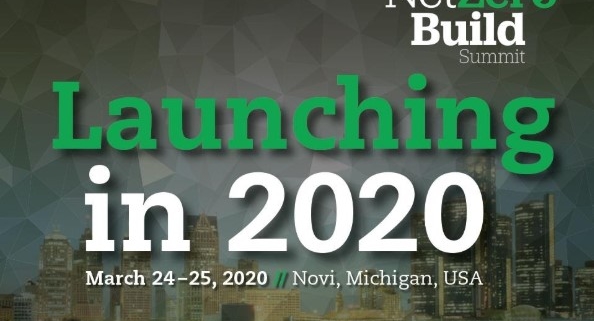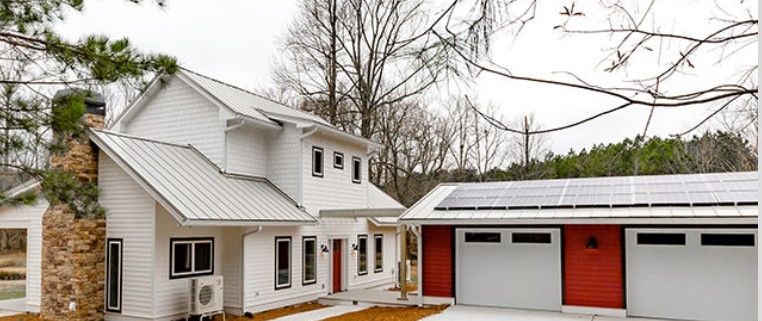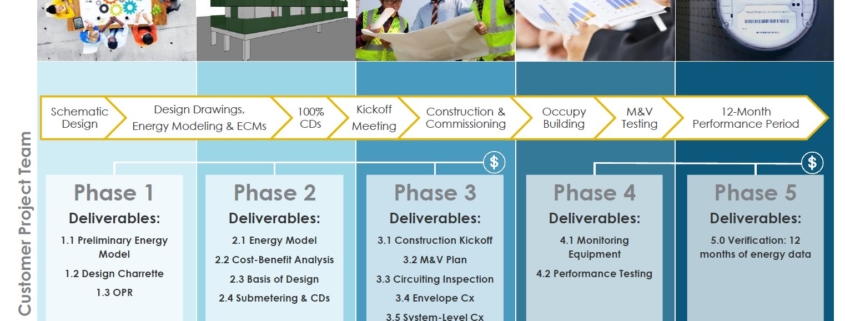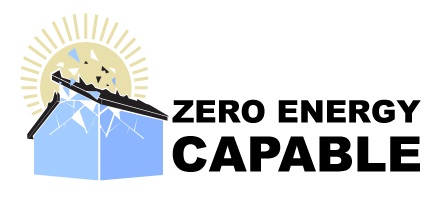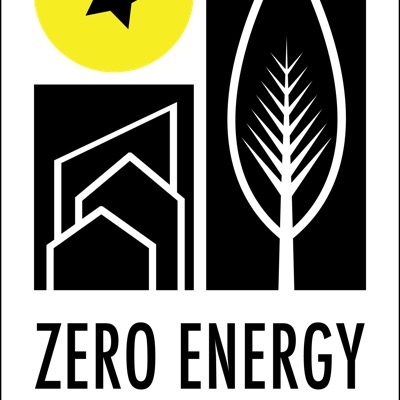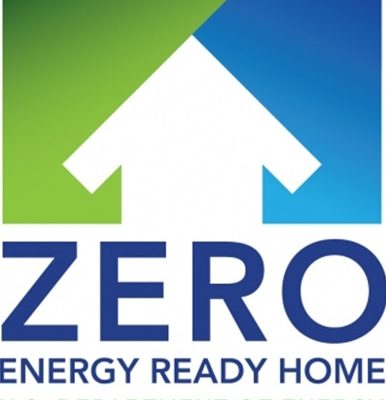Tag Archive for: Zero Energy
CEO of Mitsubishi US picks up Zero Energy Capable Certification
/0 Comments/in Local, Certified Homes, Illinois, Indiana, Massachusetts, Michigan, Minnesota, Ohio, Single-Family Projects, Wisconsin, Zero Energy Capable/by Brett LittleConsumers Energy boosts performance-based incentives and more, ready’s for zero!
/0 Comments/in Local, GRGAH, Michigan/by Brett LittleConsumers Energy is offering some new rebates and incentives focused on performance-based energy reduction for new and existing commercial and mixed-use/multifamily as well as new single-family homes. For new and existing multifamily properties they are allowing some new pilot incentives for heat pump HVAC and water heaters.
For mixed-use multifamily & commercial, they have a new program that pays out to $150,000.00 and for single family new builds, they pay up to $2,000.00 per home!
The mixed-use program is called their Zero Net Energy Companion Program but don’t let that scare you as it really is an energy reduction program with some requirements to get ready for solar in the future. It pays a $1.50 per square foot, more than twice their business incentives for projects that can ideally achieve 25 kbtu per square foot per year in your energy model at $.75 / square foot and the remaining $.75 will be paid out of a 12 month performance period showing actual results. Since some buildings are very unique so they are also allowing you to achieve this by instead being 40% better than the MI commercial energy code on new construction or major guts or 30% better on existing build upgrades. This incentive also covers the cost of LEED and/or Zero Energy certification program fees and requires early design planning, charrettes, energy modeling as well as commissioning after construction.
Learn more here or download the handout here!

Keeler Design Charrette Meeting to discuss achieving CE ZNE program on a mixed use in Grand Rapids.
For Single Family and townhouses, consumers energy is offering $2,000 for achieving a HERS index of 56 or lower, obtaining energy star homes certification and having an all-electric HVAC system. If Geothermal is out of your price range that is ok! Air source heat pumps will get the job done and now work in cold climates as well as Heat Pump Water Heaters. Learn more about the program.
For new and existing multifamily it is getting harder to comply with appropriate heat load calculations by using traditional forced air single-stage gas furnaces. Ducted or ductless air source heat pumps not only save a lot of energy but also comply with sizing requirements to make sure the system performance is at it’s peak. Not adding gas lines or venting also can save on costs as well as reduce air loss and pest entry. While heat pump water heaters steal heated air from inside our buildings they also dehumidify and are roughly 300% more efficient than traditional resistant water heaters. Most multifamily buildings have more issues with higher cooling loads than heating loads so heat pump water heaters help out with that in in the cooling season despite the small heat load they add in the winter. Our models are showing anywhere from $100 a year to $800 a year per unit in energy savings by switching from resistance to heat pump. As such, consumers is now recognizing this and adding custom rebates to help with the additional upfront cost of air source and hot water heat pumps! Learn more here about rebates for multifamily and contact consumers on custom heat pumps for your project.
We applaud consumers energy for helping lead the transition in making our buildings and homes more efficient and healthier!
Whether you are doing mixed-use, multifamily or single family GHI is here to help you or connect you with someone who can help you get access to these incentives and make your project better! Get at us today Brett.Little@greenhomeinstitute.org 616-458-6733
10 tested pro-tips to getting to zero energy
/0 Comments/in Local/by Brett LittleGetting to zero energy is easier now than ever. Costs are coming down and building codes are changing so the bar is already set higher. Return on investment in these types of homes are coming quicker as energy prices begin to climb. According to the Net zero energy coalition there over 13,000 units and a 70% gain of zero energy or zero ready homes in 2017 over 2016
But what makes a building zero energy and how can it be done?
First, you need to know the terminology.
Net zero, zero net energy, net zero energy, zero energy buildings, net positive, no utility bill, zero energy ready, off grid…. to name a few. So many terms out there, it really is the wild west.
So how do we define it?
Let’s start with what net zero is not
It’s not…
- Offsetting electric bills from lighting and appliances only
- It’s not having battery systems
- A HERS Index of 0
- It’s not being off grid
- It’s not buying renewable energy credits
It’s also not being a LEED Platinum or all-electric home either, THOUGH, those may help. We will get to that later
So what is it?
A zero energy home is one that uses on-site renewable energy to produce at least as much energy as consumed over the course of a full year
Easy
But how does the market know it is net zero? How do you prove it?
3rd party, independent certification systems can help
- International Living Future Institute Zero Energy Certification
- Passive House (PHIUS) Source Zero
- Earth Advantage Zero Energy Certification
- GHI – Zero Energy Capable
- DOE or GHI Zero Energy ready (for those who cannot afford renewables yet!)
But how do we achieve these lofty certifications and where do we start?
Based on several projects we have seen over the years have been able to compile a list of the top 10 pro tips to getting zero energy with ease. These tips are mostly in order of importance, however, some can change depending on your local opportunities, challenges or whether you are doing renovations vs new.
- Commit.
- Know what you are working with
- Befriend the sun
- Right-sized spaces
- Aim for passive house
- Why guess when you can know?
- Electrify everything
- Be picky but smart.
- Go green.
- Reduce and then produce!1. Commit
Commitment is key. You cannot make the challenge unless you are on board. We need the whole team. The owner, developer, building manager, builder, designer, HVAC and yes, even the landscape architect will play a role. Sure, there will be some naysayers and that is ok, they will challenge you along the way to ensure you are thinking through your decisions. Getting the team together for a few preliminary design meetings and defining roles and task always helps. Maybe the people being hired on the job should also sign a contract or have it in their contract to hit zero. When looking to hire look for those involved in green building or zero energy projects on their resume. Everybody plays a role and it is important that everyone understand how they contribute to the goal and how it is connected to others role. Having clear communication and intent from the start is the biggest hurdle and yet the easiest place to start when getting to zero.
- Know what you are working with
You have to know what renewable resources are available on the site you plan to build or renovate on or if you are luckily enough to have a choice, you can select a lot based on its supreme renewable energy resources. Now you may want to assess wind, sun, water and earth for your energy but for the most part, projects are usually only going to benefit from the sun and earth, based on current technology. So unless you are next to a large body of water, running stream or are in a very windy rural area. Solar and geothermal are going to be the way to go and what we discuss here.
With solar, you can easily use the National Renewable Energy Laboratory PV watts program to determine the solar income of the site. You can see what energy is hitting the site or an existing structure and determine then how much energy is needed. This is important because it tells you how much renewable energy is available on that site and tells you the constraints you are working in to get to zero or what you may need to do find other renewable resources. PV watts has nothing to sell you either, it is a federally backed program that gives you information. Many areas have solar PV experts and installers who can also assess the site, many times for free as well.
When it comes to earth we are talking geothermal HVAC (aka ground source heat pumps). Ideally, you are looking for a site with some acreage where you ideally do not need to remove trees or where you plan to remove them for the project. In this case, a very small body of water may actually improve the geothermal performance. If you have an existing lot, a small lot or one that is very wooded where you don’t want to kill trees, the geothermal expert will recommend drilling vertically. Don’t forget to check local regulations for how close you can drill to someone’s property or what is below! Geothermal is defiantly not necessary on all zero energy projects but we will get to that later.
- Befriend the sun
The sun can be your friend or your enemy. Most homes these days just try to keep it out. Keeping glass off the south end. That’s a good start but you can also use it to your advantage. In cold weather climates, the sun goes high in the summer and you can use overhangs or smart curtain systems to easily keep it from coming in the home and overheating it. Energy star certified roofs too help reflect it out as well. In the winter time, you want that low sun coming into the house. It can be used to heat concrete floors, Trombe wall systems and/or thermal mass walls such as concrete, rammed earth or straw. This will radiate heat back out at night if designed correctly. Passive ventilation/cooling can be done using the proper placement of windows to strategically keep occupants cool in the offseason.
Check out some free passive solar design-based tools here. Using these methods can easily cut energy use in homes and buildings, sometimes for less or no additional cost and require no maintenance. Bonus, overhangs improve the life of doors and windows and so there is a 2 for 1 there.
- Right-sized homes & spaces
This is very important because most of our energy is used by simply heating, cooling and ventilating space. Imagine if you can design a home that heats less space but feels just as large? Nationally, Sarah Susanka discusses the not so big house concept but in Grand Rapids Urbaneers are already at work with products like moveable walls, wall beds, adjustable kitchen islands, Milwork + storage, compact & prefab kitchens to name a few. This home in Portland, OR is an extreme example of right sized living and making the best use of space. Minimal surface to volume area may mean 2 story homes vs longer 1 story homes or just, to be honest, encourages multifamily as opposed to single family for more efficient usage of space in urban areas. Just look around online for countless of examples of doing more with less and therefore demanding less energy.
- Almost passive house
Passive house has the most rigorous standards that are climate appropriate in the US based on where you are at. These include low energy demand, a super tight building shell and low energy per person per year. They give good estimates on the R value of insulation/windows from under the ground to the attic. Try your best to follow these to get to a low demand building before thinking about the mechanical systems. Learn more on the PHIUS website. Innovations in this area include Structurally Insulated Framing Systems (SIFS) that are affordable ways to still build a conventional home or building but save a lot of energy in the walls. When you have a super tight house you need to make sure you are using balanced ventilation and fresh air which can take energy but there is a smart ventilation system that runs very low but only ramps up when poor air quality is detected in the home. A good way to save energy and keep clients healthier in almost passive house projects.
- Why guess when you can know?
Now that you have your designs thought through well-using steps 1 – 5 you might just be crossing your fingers you made it but why guess? Energy modeling has now moved from an art to a science. We can now model with over 90% accuracy and predict how much energy a building will use. During the design process, you can hire an energy rater to come up with a preliminary model that shows a 0 consumption. As the plans change, communicate with the rater so they can make sure you are still on track. Then the same rater will do inspections during pre-drywall and final to ensure what is in the model actually was installed. For existing homes you would do an energy inspection to get a starting place. These things are typically already required by code and may get incentives. The most popular tool for lowrise residential buildings is REMrate (HERS Rating) and this software can show what parts of the design are performing well or underperforming. A good HERS rater will help you find cost-effective ways to reduce energy in those areas to get the home to zero. Other tools are the DOE Home Energy Score for renovations, WUFI passive for all project types and ASHRAE 90.1 or Level II for larger buildings and commercial. Make sure you get a good rater who knows what they are doing.
- Electrify everything!
Eliminating combustion ensures your HVAC maximizes energy efficiency and uses energy that can be directly offset by renewable energy. These systems are also now price competitive with fossil fuel systems. Typically we are talking heat pumps for heating, cooling and water heating. They can be air source, ground source (geothermal) or some combination of the 2. Ductless mini splits can eliminate the cost of expensive ductwork and air source heat pump furnaces only require one device that works like reverse air conditioning in with winter. Geothermal (aka – Ground Source Heat Pumps) is the most expensive and needed to get older existing homes or larger homes to 0. They also come with a 30% tax deduction for several more years. Most gas furnaces are oversized if you are following the above steps and so these electric HVAC systems are typically smaller to fit the lower demand. For water heating, heat pumps now are the most efficient and can be used to dehumidify or be ducted to stop it from taking the energy your clients paid for from the indoors. Going all-electric is a new concept in many areas but the latest report from Rocky Mountain Institute and another from NREL shows a lot of dollar savings to be had. A whole Facebook group is dedicated now to strategies to electrify all our buildings. Come join us here.
- Get picky but be smart.
At this point you have likely removed 80 to 90% of the energy use of a home through good design and better HVAC. Now it’s time to work with your clients, homeowners, and tenants to get real (really!) picky.
Use very low watt LEDS ( 4 to 8) lamps, light switch or bulb ready motion / photo sensors / dimmers, and all energy star appliances. Make use of low flow devices, hot water pipe wrap, and smart power management systems. Have instant utility usage information on a per plug basis which shows how much energy you are using. Ceiling fans can help keep you cool as opposed to AC. Try induction stoves which cook just like gas and are way more energy efficient because they heat pans only when needed. Use heat pump dryers which are the most efficient and work great. As a builder/designer, you can specify these systems and have a homeowner training/manual to show your clients how to operate these systems to keep energy usage to zero. Developers, landlords and owners can continuously train new and existing tenants and use green leases or energy competitions to keep bills low!
- Go Green!
Building green gives you guidance on how and what to do. Most green programs have a checklist you can follow to keep you on track. Typically, tight homes can cause health issues so green building gives you health strategies to follow. Following the indoor air quality requirements keep your clients safe, healthy and alive! Water conservation is also a big part of green building, this keeps utility bills low and can play a role in keep energy bills low too for hot water demand. Using a green certification increases home value + tenant retainment and is an easy way to communicate sustainability goals and a fall back if you just don’t make it all the way to zero. For a comparison of all the green certifications and which is right for you and you clients, go here.
- Reduce and now produce!
Say it with me.
Reduce.
Reduce.
Before you… Produce
Let’s face it, renewable energy is expensive and needs a lot of infrastructure. So by following all those other steps you now just reduced your demand so low for energy that you really don’t need that much solar. Before you even go solar in your project you can wire the electrical system to the roof, increase the size of the breaker box and make sure there is proper roof orientation or open space for a ground mount is there to add enough solar. This is called a zero energy ready and am an easy place to start. DOE has created a solar-ready checklist you can use on your next project.
Once the owner has the funds to go solar they can simply add a small amount in the future and achieve zero energy with minimal efforts. Obviously going solar during the project will be the easiest and cheapest to do right away but it’s not always feasible. Designed right you should only need between 5 – 12 KW of solar pv depending on your climate, home size and location. There now are affordable shingles that also double as solar panels. Imagine getting rid of toxic asphalt shingles for your clients and replacing it with money generating solar energy shingles that can also the get 30% federal tax deduction? That is a win/win.
If your client is looking to use an electric car or have a battery backup system during power outages, you may be considering a larger system to handle the electric carloads in the future, you can do that part in the energy model in #5 and survey your clients on their driving habits. Check out this family in MN powering their cars and home all on electric and solar. Some call it the new American Dream.
Ultimately, if done right, getting to zero energy should be affordable for everyone, especially in new builds and major renovations. While there is typically an added costs, folks like greenspaces in TN are challenging that notion and partner with builders to build market-rate cost competitive zero energy homes and it is working.
Are you up for the challenge?
Passive House in the Woods – GreenStar Gold
/0 Comments/in Local, GreenStar, GS Gold, New Home, Passive House, Wisconsin, Wisonsin, Zero Energy Capable, Zero Hero Award/by Brett LittleThe Passive House in the Woods [Konkol residence] is a single-family home located in the Town of Hudson, Wisconsin. Located on a one-acre lot on the outer edge of a residential development the home overlooks the St. Croix River valley. The building lot provides stunning views and prime passive solar exposure. With its renewable energy systems, the structure makes more energy than it consumes. It features three bedrooms and three levels, including a walkout basement, as well as a rooftop terrace.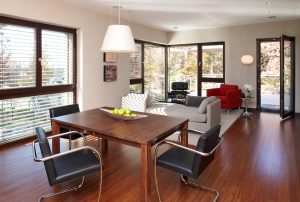
The insulated concrete form substructure was built in the winter of 2009/10, and the home finished in September of 2010. The project is Wisconsin’s first certified Passive House and at the time, one of only a handful of certified Passive House projects in the United States of America.
The building envelope of the Konkol residence is very uniform. The below and above grade walls are made from the same insulated concrete form (ICF) assembly with exterior insulation and finish system. The basement slab rests on foam insulation—the roof deck is topped with foam insulation. The continuous concrete pour inside the ICF forms offers tremendous strength and helps with airtightness. R-values are very high and continuous. Both the garage as well as the exterior steel stair and deck structure are self-supporting and do not interrupt the building envelope.
The North side of the home is largely covered by the garage, which is essentially built up to the home but does not share any assemblies with it—making the house’s envelope continuously the same. There aren’t any windows on the North side at all. The south side opens up for maximum solar heat gains, which are managed by motorized exterior shades.
Covered entry and garage access are located on the main level from the East. The main stair is located along the North wall with storage cabinets lining it on each floor. The main level holds the kitchen, dining, and living area, as well as a powder room. Storage, mechanicals, and a guest suite/ family room are located on the walkout level, which provides access to the backyard.
The upper floor contains two bedrooms and a joint bath/ laundry room. Both the main and upper floor offer access to the exterior decks on the West side, as well as the exterior stair structure on the North side, which connects all levels from the ground to the rooftop terrace. The rooftop terrace holds part of the photovoltaic system and the solar thermal panel. It offers spectacular views over the St. Croix River valley.
The building was designed from the outset to become a Passive House. The first energy model was completed during schematics and subsequently kept current with design evolutions. The construction methods were selected specifically with airtightness in mind. Fenestration and glazing were fine-tuned using the energy model.
In an effort to deliver a holistic and sustainable design, the building was also designed to meet the Minnesota GreenStar Gold level of certification focusing on energy efficiency, resource efficiency, water conservation, indoor environmental quality, and site and community impact.
Fast forward to 2015
This project is our first ever Zero Energy Capable Designated home which means it was designed and tested to be a low energy usage home and be completely offset by renewable energy. Not only that but the Konkol family has gone to great lengths to actually prove the home can obtain Zero Energy in their utility bills and have produced 300 more KWH than they used. This is why we are awarding them with our Zero Energy Hero award for the year 2010 – 2015. They produced 300 kwh more than they had used. You can see their energy use and generation here. 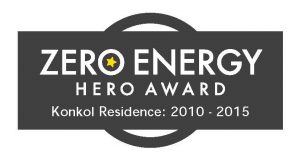
Tim Eian, the project architect explains this in more detail.
“In year 1 we identified a couple of commissioning errors, which upon evaluation, were fixed. This lead to lesser consumption in subsequent years. In 2014 we understand that the solar thermal preheater panel failed (after repeated issues with the solar thermal hardware) and it took some time for it to be replaced, during which electric resistance hot water generation caused a higher than normal energy consumption. In addition, the tracker mechanism on the PV array failed repeatedly and is, as far as I know, defunct now, leaving the panels at a static position, rather than tracking. It is very frustrating to see the renewable systems causing many problems but re-assuring for the envelope-first approach we chose.
You will note at the bottom, that despite the issues with equipment, the overall balance for the site as of last month is still net positive. Please also note that the site is on a well with water filtration, which accounts for approximately 700 kWh per year (we monitored this for a few years), which a home on the water grid would not incur. The owner also maintains a large edible garden, which needs watering in summer and fall. The meter is accounting for all site loads, including the water well and filtration system, exterior lights, etc.”
You can read more about the project costs from this recent Fine Home Building Article
http://www.finehomebuilding.com/item/143324/the-low-cost-of-passivhaus-living#ixzz3pmBZl3PB
Highlights
• Passive House solar design
• Certified Passive House, PHIUS+ and GreenStar Gold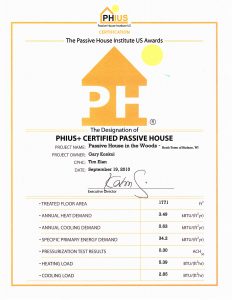
• 4.7kw Photovoltaic and solar thermal renewable energy systems
• Modern custom design, compact floorplan layout
• Very high-performance thermal envelope R-70 walls, an R-60 slab and an R-95 roof.
• Rooftop terrace and green roof
• Interior walls are made with American Clay Plaster which healthier material that manages moisture
• Extensive gardening
• German-made Optiwin windows and motorized exterior sunshades
• Heat-recovery ventilation system with earth loop
preheater
Project Team
Design: Dipl.-Ing. Tim Delhey Eian, TE Studio, Ltd.
Interior Design: Christine Frisk, InUnison, Inc.
Landscape Design and Civil Engineering: Laurie McRostie
Structural Engineering: Mattson MacDonald Young
Lighting Design: Carol Chaffee, Carol Chaffee Associates
Construction: Morr Construction
Renewable Systems: Energy Concepts
GreenStar Rater: Pat O’Malley – Building Knowledge
Members enter in a drawing to win! New Net Zero
/in Uncategorized/by Brett LittleNew Net Zero: Leading-Edge Design and Construction of Homes and Buildings for a Renewable Energy Future.
Green Star members enter a chance to win below! Deadline is July 31st
The Comprehensive Guide to Net-Zero Standards and Techniques, Including Construction Details
The new threshold for green building is not just low energy, it’s net-zero energy. In The New Net Zero, sustainable architect Bill Maclay charts the path for designers and builders interested in exploring green design’s new frontier: net-zero-energy structures that produce as much energy as they consume and are carbon neutral.
In a nation where traditional buildings use roughly 40 percent of the total fossil energy, the interest in net-zero building is growing enormously—among both designers interested in addressing climate change and consumers interested in energy efficiency and long-term savings. Maclay, an award-winning net-zero designer whose buildings have achieved high-performance goals at affordable costs, makes the case for a net-zero future; explains net-zero building metrics, integrated design practices, and renewable energy options; and shares his lessons learned on net-zero team building.
Both new-building and renovation projects are covered in detail. The New Net Zero is geared toward professionals exploring net-zero design, but also suitable for nonprofessionals seeking ideas and strategies on net-zero options that are beautiful and renewably powered.
“This book will become a game changer at a pivotal point in history. The New Net Zero is a technical manifesto that brings together engineering, ecology, architecture, energy, the construction industry, transportation, and design into a coherent whole. . . Immensely practical, thorough, and technologically comprehensive: it is a masterful job.”—John Todd, founder, John Todd Ecological Designs
Of The New Net Zero, The New York Times recently wrote: “Books by architectural firms are often vainglorious marketing efforts that keep the content glossy and light. But an ambitious new book … challenges the genre.” Read the full Q&A online.
Enter to win – Didn’t win? The first 50 sign ups get a 35% discount coupon code!
Tag Archive for: Zero Energy
Menu
GreenHome Institute
GreenHome Institute
ATTN José Reyna
1451 Lake Drive SE, #6484
Grand Rapids, MI 49516
Tel: (616) 458-6733
Email: info@greenhomeinstitute.org
About Us
Recent Posts
- April 2024 GreenHome and Sustainability Jobs Round-Up.
- Protected: Public comment on Inflation Reduction Act Home Rebates opening in MI and beyond
- Shawn Neinhouse completed Certified GreenHome Professional Training
- Please take this MSU Student’s Mass Timber Survey
- Clean Energy Credit Union Clean Energy For All Reduces Barriers

